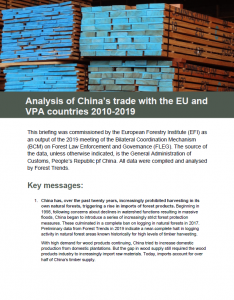Analysis of China’s Trade with the EU and VPA Countries 2010-2019
By EU FLEGT Facility and Forest Trends View PublicationThis paper assesses China’s forest product imports from FLEGT VPA countries and exports to the European Union (EU) plus European Free Trade Agreement (EFTA) Member States between 2010-2019, set within the context of overall trade and market dynamics driving China’s supply and demand for forest products.
We demonstrate that following China’s closure of its own forests from harvesting and the subsequent rise in imported forest products, imports reached historic highs in 2018 even as exports remained stable –indicative of a growing domestic market. Long dominated by raw wood material (logs and sawnwood), China’s timber product import mix is shifting to more semi-processed wood products such as veneer and particleboard as supplier countries embrace incentives to keep value-added processing within their borders. The pulp and paper mix has shifted far more dramatically since China banned waste imports, including recycled paper, in 2018. China’s direct forest product imports from countries implementing or negotiating a FLEGT VPA increased 155% by volume, and 106% by value between 2010-2019. In terms of exports, China and the US are the largest destination markets for forest products from VPA countries, with China’s market share of imports from these countries nearly tripling over the past decade (in contrast, EU and EFTA Member States’ share of forest product imports from VPA countries fell by nearly half). In total, more than half of China’s timber product exports were bound for regulated markets which have passed measures to exclude illegally-sourced timber, with exports to EU and EFTA Member States increasing 41% by value, but just 21% by volume. The China-US trade war has also impacted the timber trade, with evidence that China is shipping wood product exports through Vietnam and onward to the US to circumvent tariffs.
China’s forest product imports from some tropical forested countries are at high risk of being harvested or processed in contravention of the law. Forest Trends assessed China’s overall forest product imports across three “risk indicators” that are tied to illegal logging: poor governance, conflict, and the presence of a full or partial log or sawnwood export ban, and found that a significant portion of China’s forest product imports were from countries deemed at higher risk of poor governance, countries included on the World Bank Harmonized List of Fragile Situations, and those that have instituted export restrictions for logs and sawnwood. Because there are no mandated, robust chain of custody systems, it remains difficult to trace wood material within Chinese supply chains from import to export points, particularly complex supply chains for processed products such as plywood and furniture. China’s newly-revised Forestry Law, which entered into force in July 2020, prohibits purchasing, processing, or transporting illegally-sourced timber. Going forward, the State Council and relevant ministries could use the existing domestic timber legality supervision system to formulate relevant implementing regulations applicable to timber imports to ensure legally-verified sourcing.
This briefing was commissioned by the European Forest Institute (EFI) under the EU FLEGT Facility as an output of the 2019 meeting of the EU-China Bilateral Coordination Mechanism (BCM) on Forest Law Enforcement and Governance (FLEG). It is based on existing literature and a desk analysis of trade flows. The source of the data, unless otherwise indicated, is the General Administration of Customs, People’s Republic of China, compiled and analyzed by Forest Trends. The paper can be viewed at http://www.euflegt.efi.int/es/publications/analysis-of-china-s-trade-with-the-eu-and-vpa-countries-2010-2019

